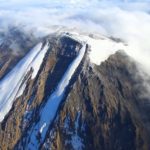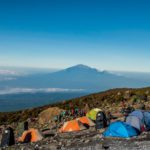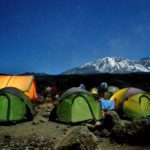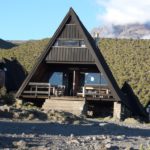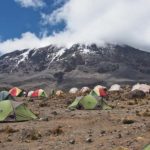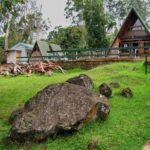6 Days Machame route
The Machame Route, also called the Whiskey Route, has gained a lot of notoriety. This route is ideal for camping and provides breathtaking views of a variety of landscapes, including Mt. Meru, the Pare Mountains, Lake Chala, and Lake Jipe. Although the 6-day itinerary is very feasible, it is much more advantageous to do the Machame climb in seven days because you get an extra day to acclimate and rest before the summit day. By doing this, you will minimize your risk of experiencing altitude sickness and increase your likelihood of reaching the summit.
Itinerary
The highest peak of Africa is 6 Days Machame route.
Day 1: Machame Gate (1828m) – Machame camp (3020m)
Forest section Machame route your day starts early with breakfast, followed by a 45-minute drive from Moshi (910m) to the Machame Gate (1828m). The guides and porters prepare and pack the supplies and your equipment at the gate. After registering at the gate office, you start your ascent and enter the rainforest almost immediately. There is a strong possibility of rain in the forest, which will transform the trail into a very soggy, muddy and slippery experience. You will have a welcome lunch stop about halfway and will reach the Machame camp (3020m) in the late afternoon. Your porters (arriving at the camp site long before you) will have erected your tent on arrival. In the evening the porters will bring a small bowl of washing water to your tent and the cook will prepare dinner, before you retire to your tent for the night. Night temperatures can already drop to freezing point at this campsite
Hiking time: 7 hours
Distance: Approximately 10.8 km
Day 2: Machame camp (3020m) – Shira camp (3847m)
On the way to Shira camp, you rise early at Machame camp and after breakfast, you climb an hour or so to the top of the forest and then for 2 hours at a gentler gradient through the moorland zone. After a short lunch and rest, you continue up a rocky ridge onto the Shira plateau. By now you will be able to see in an easterly direction, the Western Breach with its stunning glaciers. You are now due west of Kibo and after a short hike, you will reach the Shira campsite at 3 847m. The night at this exposed camp will even be colder than the previous night, with temperatures dropping to well below freezing.
- Hiking time: 6 hours
- Distance: Approximately 5.2 km
Day 3: Shira Camp (3847m) to Lava Tower (4642m) to Barranco camp (3984m)
Lava TowerThe route now turns east into a semi-desert and rocky landscape surrounding Lava Tower, where you reach an altitude of 4642m after about a 5-hour trek. Lunch is served at a designated area. This is definitely the toughest day so far. It is normally around this point, where for the first time, some climbers will start experiencing symptoms of breathlessness, irritability and headaches. After lunch, you descend again by almost 658m to the Barranco camping area.
After reaching the high altitude of 4600m at Lava Tower, the true acclimatization benefit of this day becomes clear. This descent to Barranco camp takes about 2 hours and offers great opportunities to take some beautiful photographs of the Western Breach and Breach Wall. The camp is situated in a valley below the Breach and Great Barranco Wall, which should provide you with a memorable sunset while you wait for your dinner to be prepared.
- Hiking time: 7 hours
- Distance: Approximately 10.7 km
Day 4: Barranco camp (3984m) – Barafu camp (4681m)
On the way to Barafu camp after spending a night at the great Barranco Wall (a very imposing sight at first), you make your way up this awesome-looking obstacle, which in the end usually turns out to be easier than anticipated. Topping out just below the Heim Glacier, you will now appreciate just how beautiful Mount Kilimanjaro really is. The route then heads down through the Karanga Valley over intervening ridges and valleys and then joins up with the Mweka route. This is the preferred route down from the summit, so remember it. Turn left up the ridge and after another hour or so, you should reach Barafu Hut.
The last water stop on the route is the Karranga Valley, as there is no water available at Barafu camp. Barafu is the Swahili word for “ice” and it is a bleak and inhospitable camping area to spend the night. Totally exposed to the ever-present gales, the tents are pitched on a narrow, stony, and dangerous ridge. Make sure that you familiarize yourself with the terrain before dark to avoid any accidents.
The summit is now a further 1214m higher and you will commence with your final ascent attempt, the same night. Prepare your equipment, hiking poles and thermal clothing for your summit attempt. This should include the replacement of your headlamp and camera batteries and make sure you have a spare set available as well. To prevent freezing it will be wise to carry your water in a thermal flask. Go to bed at around about 19h00 and try to get some precious rest and sleep.
- Hiking time: 8 hours
- Distance: Approximately 9.4 km
Day 5: summit attempt, Barafu camp (4681m)-Uhuru Peak (5895m)-Mweka (3090m)
view from Stella’s point You will get up around 23h30, and after some tea and biscuits you shuffle off into the night. You will head in a north-westerly direction and ascend through heavy scree towards Stella Point on the crater rim. For many climbers, the 6-hour walk to Stella point is mentally and physically the most challenging on the route. At Stella Point (5739m) you will stop for a short rest and will be rewarded with the most magnificent sunrise you are ever likely to see (weather permitting). From Stella Point, you will normally encounter snow all the way on your 2-hour ascent to Uhuru Peak. The time you will spend on the summit will depend on the weather conditions. Do not stop here for too long, as it will be extremely difficult to get going again due to cold and fatigue. Uhuru peak Enjoy your accomplishment and a day to remember for the rest of your life!
The walk back to Barafu from the summit takes about 3 hours. Here you will have a well-earned but short rest and collect the rest of your gear, before heading down to Mweka hut (3090m). The route is not difficult and will take you down the rock and scree path into the moorland and eventually into the forest. Dinner and overnight at mweka camp.
- Hiking time: 7 to 8 hours to reach Uhuru Peak, 6 to 8 hours to descend to Mweka Camp
- Distance: Approximately 4.5 km ascent and 10.8 km descent
Day 6: Mweka camp (3090m) – Mweka Gate (1641m)
The mountain crew team After an early and well-deserved breakfast, it is a short 4 to 6-hour scenic hike back to the Park gate. Some hikers do experience knee problems which could make the descent longer than planned.
At Mweka gate you sign your name and details in a register. This is also where successful climbers receive their summit certificates. Those climbers who reached Stella Point (5739m) are issued with green certificates and those who reached Uhuru Peak (5895m) receive gold certificates.
From the Mweka Gate, you will drive to a lodge or hotel in Arusha for a long overdue hot shower, dinner, celebrations and overnight.
- Distance: Approximately 8.5 km,
- Hiking time: 4 to 6 hours
Day 7: Departure day
After saying bye to your guides at porters you will be transferred to Kilimanjaro International Airport (JRO) for your flight back home.
Why Travel With Us
- Great online reviews
- Long-term experience and expertise
- Customer-centered service
Let us plan your dream Tanzania trip!
Long or short Tanzania safari planning can seem overwhelming. But it’s not necessary to be! There is a pool of travel professionals with more than Eighteen Years of experience. Within 24 hours of your inquiry, an African safaris planner will contact you!

